Cameroon
Cameroon in long form the Republic of Cameroon (in English: Cameroon and Republic of Cameroon), is a country in central Africa, located between Nigeria in north-northwest, Chad in north-northeast, the Republic Central African to the east, the Republic of Congo to the southeast, Gabon to the south, Equatorial Guinea to the southwest and the Gulf of Guinea to the southwest. The official languages are French and English. Before the colonial period, the inhabitants did not form a single homogeneous group and presented several forms of social activities ranging from structured kingdoms to nomadic ethnic groups. The ancient kingdoms (Bamoun, Bodjongo, Adamaoua, Garoua) succeeded in the 19th century the German colony which placed Cameroon under protectorate. At the end of the First World War, Cameroon was placed under the supervision of the League of Nations and entrusted to the administration of France for its eastern part and of the United Kingdom for its western part. The former UN mandate under French administration gained independence under the name of Republic of Cameroon on January 1, 1960. It was joined by part of the territory under British administration in October 1961 for the former Federal Republic of Cameroon which, on May 20, 1972, was renamed the United Republic of Cameroon, then the Republic of Cameroon in 1984. As for most African States, Cameroon and its current borders therefore result from European colonization which encountered the borders between the same families such as Mvomekaa which is found in Cameroon and Gabon. Cameroon is today an ex-officio member of the International Organization of La Francophonie, of the Commonwealth and of the Organization of Islamic Cooperation. Cameroon is nicknamed “Africa in miniature” because of its climatological, mining, geographic, human and cultural diversity. The west of the country has an important volcanic chain dominated by Mount Cameroon.
Cameroon’s history:
The first inhabitants of Cameroon are probably the Baka hunter-gatherers, Pygmy nomads. But, from the 1st millennium BC. AD, sedentary societies of farmer-breeders are developing, perhaps coming from the Sahara then in the process of desertification and the Baka are pushed back into the forests of the southern and eastern provinces where they are still found. . Among the sedentary people, those from the southwest of present-day Cameroon and the southeast of Nigeria are the most anciently attested as using Bantu languages. These languages then spread throughout most of western sub-Saharan Africa, as far as South Africa, probably at the same time as agriculture. The first historical allusion to the Cameroonian coasts is found in the story known as the Hannon Periplus, in a much-discussed Greek text. In the fifth century, this Carthaginian reaches Mount Cameroon which he baptizes the Chariot of the Gods. But this text is controversial for its approximate translation since the Phoenician and especially because there is no archaeological evidence that the Carthaginians went south of Essaouira. On the other hand, we are certain that, in 1472, the Portuguese sailors of the navigator Fernando Pó entered the Wouri estuary, ecstatic about the abundance of shrimp in the river they immediately call Rio dos Camarões (shrimp river). English sailors adopt this name by anglicizing it (Cameroons), hence the current name of Cameroon. After the Portuguese come the Dutch then the Germans. Through contacts with Europeans and Sahelians (Kanem-Bornou kingdom) regular trade begins. The development of the slave trade, either western or eastern, the spread of Christianity by the south and Islam by the north, profoundly changed the societies of Cameroon, favoring structured groups having adopted a monotheistic religion and capable of procuring firearms, to the detriment of the previous political organization (like the Bamoun kingdom).
In order to protect their commercial interests, the Germans established on July 5, 1884 their protectorate by the name of Kamerun. Germany is particularly interested in the agricultural potential of Cameroon and entrusts large companies with the task of exploiting and exporting it. Chancellor Otto von Bismarck defined the order of priorities as follows: the merchant first, the soldier second. It was indeed under the influence of the businessman Adolph Woermann, whose company established a trading house in Douala, that Bismarck, at first skeptical about the interest of the colonial project, was convinced. Large German commercial companies and concessionary companies established themselves massively in the colony. Leaving the big companies to impose their order, the administration contented itself with supporting them, protecting them, and eliminating the indigenous rebellions. In order to ensure the economic development of the protectorate, the Germans embarked on important works: construction of roads and the first railway line, start of work on the port of Douala, construction of schools and hospitals, creation of large plantations (cocoa, banana, coffee, rubber, palm oil …). But most of the local people are subjected to forced labor and corporal punishment. As for the Baka, they are trapped and studied like animals; some are taken to Germany to be shown, in cages, in colonial exhibitions. In 1918, the Germans lost their colony due to their defeat in the First World War; the League of Nations then entrusted most of the country to France and two western pockets bordering Nigeria (British colony) to the United Kingdom. During the first twenty years, France worked in particular to liquidate the rebellions of Kirdis populations in the north of Cameroon. If the pacification of this region is accompanied by recurrent massacres and looting, France, unlike Germany, also practices a policy of assimilation like what happens in its other colonies. The United Kingdom applies the indirect rule regime.
In the aftermath of the Second World War, the movement of the UPC (Union of the populations of Cameroon), led by Ruben Um Nyobe, claimed independence and reunification before being prohibited and then repressed by the French in Bassa country and in Bamileke country (“Bamileke war”). The independence of the French zone was proclaimed on January 1, 1960, Cameroon becoming the first of 18 African colonies to gain independence in 1960. Reunification took place the following year with the southern part of the British zone (Cameroon from the South), the northern part (Northern Cameroons) having opted for union with Nigeria. However, this independence remains largely theoretical since French “advisers” are responsible for assisting each minister and have the reality of power. The Gaullist government preserves its ascendancy over the country through the signing of “cooperation agreements” affecting all sectors of Cameroon’s sovereignty. Thus, in the monetary field, Cameroon keeps the CFA franc and entrusts its monetary policy to its former guardian power. All strategic resources are exploited by France and troops are maintained in the country. There followed a period of violent repression against the UPC movement, and the ALNK, its “National Liberation Army of Kamerun”, by the new government with the assistance of France, which lasted until the late 1960s. From Kamerun! A hidden war at the origins of Françafrique, it was French officers who, during the 1960s, secretly led the repression operations carried out by the Cameroonian army against the last bastions of the “upecist” insurrection, mainly in the west of the country. Tortures, regrouping and forced displacement of populations, extrajudicial executions, psychological warfare, villages razed or bombed with napalm, the methods used are gradually transmitted by the French soldiers to their Cameroonian counterparts, in particular within the École Militaire Interarmes du Cameroon (EMIA), led during this period by French officers trained in the doctrine of revolutionary war (DGR). On May 20, 1972, a referendum led to a unitary state and put an end to federalism.
At the end of the 1990s, Canadian “junior companies”, invested in more than 8,000 mining properties, in more than 100 countries, most of which were still in the planning stage14 multiplied contracts with African countries, including Cameroon. , where Mega Uranium has concessions over 4,654 km2 . The American ambassador to Cameroon, Niels Marquardt organizes the trip of Prime Minister Ephraïm Inoni in the summer of 2007 to the United States, during which the Cameroonian delegation is oriented towards Canadian, American, British and Australian mining companies . At the end of 2016, a separatist movement initiated a conflict in the two English-speaking regions of the North West and the South West. On October 1, 2017, Sisiku Julius Ayuk Tabe symbolically declares the independence of the Republic of Ambazonia on the territory of these two English-speaking regions of the North West and South West, triggering a repression by the police forces resulting in by the dead, the wounded, riots, barricades, demonstrations, curfews, etc. Paul Biya was re-elected for a seventh term in 2018, in a ballot whose regularity is challenged by the opposition. He launched a “great national dialogue”. No decisive progress emerges on the crisis in the English-speaking regions. Paul Biya frees detainees, but the leaders of the movement remain in prison.
Cameroon’s economy
From 1965 to 1985, Cameroon experienced sustained growth (more than 15% per year on average), driven by the prices of raw materials, and was for a long time among the most prosperous countries on the African continent. The economic situation then deteriorated sharply until the devaluation in January 1994 of the CFA franc, preceded by a drastic reduction in wages of around 70%. After a decade of recession characterized by a sharp drop in GDP (-30% between 1985 and 1993) and a drop of 40% in per capita consumption, Cameroon has returned to economic growth since 1994. Its GDP (around 42.750 billion US dollars in 2009, or 2,300 US dollars per capita in PPP) today represents half that of the Economic and Monetary Community of Central Africa (CEMAC), which gives it an important place at the regional level. In terms of imports, Cameroon’s main economic partners are France (19.1%), China (13.3%), Nigeria (12.4%). For exports, these are Spain (15.1%), the Netherlands (12.8%), China (9.4%), Italy (9.3%), France (6 ,5%) and the United States (6.4%), in 20103. Public debt constitutes 14.3% of GDP (2009), while external debt is around 2 929 billion US dollars (estimate 2009). Cameroon became an oil producing country in 1977. Pretending to want to make reserves for difficult times, the authorities manage oil revenues “off budget” in the most total opacity (funds are placed in Parisian, Swiss and New- Yorkers). Several billion dollars are thus diverted for the benefit of oil companies and officials of the regime. The influence of France and its 9,000 nationals in Cameroon remains considerable. African Affairs magazine noted in the early 1980s that they continue to dominate almost all key sectors of the economy, much like they did before independence. French nationals control 55% of the modern sector of the Cameroonian economy and their control over the banking system is total.
Cameroon’s demography
The population of Cameroon is estimated in 2015 at 20,000,000 inhabitants. At the time of the country’s independence in 1960, Cameroon had just over 5,000,000 inhabitants. In 2001, 6 cities exceeded the threshold of 200,000 inhabitants: Douala (the economic capital, 1.5 million inhabitants in 2001), Yaoundé (the political capital and seat of institutions, approximately 1.25 million inhabitants in 2001 ), Garoua (approximately 357,000 inhabitants in 2001), Bamenda (approximately 316,000 inhabitants in 2001), Maroua (approximately 272,000 inhabitants in 2001) and Bafoussam (approximately 242,000 inhabitants in 2001).
However, demographic estimates vary from source to source. According to the government daily Cameroon Tribune (based on weekly special reports in a city in the country during the years 2008 and 2009), the ten most populated agglomerations are: Douala (2.2 million inhabitants), Yaoundé ( 1.7 million), Garoua (600,000), Bafoussam (400,000), Nkongsamba (300,000), Bamenda (280,000), Édéa (250,000), Kribi (220,000), Maroua (220,000) and Ngaoundéré ( 200,000). Cameroon has a total of twenty cities with at least 50,000 inhabitants. According to the results of the last census, Cameroon still has slightly more women (50.6%) than men (49.4%). Half of the population is under 17.7 years of age and the demographic weight of those under 15 is 43.6%. People over the age of 60 represent only 5.5% of the total population. Despite a constantly growing urban demography, a majority (from 55% to 65% according to estimates) of the population remains in rural areas. The most densely populated provinces (over 100 inhabitants / km2) are the West, Littoral, Far North and North West provinces. On the other hand, the provinces of Adamoua, the East and the South are very sparsely populated (less than 15 inhabitants per km2).
Depending on the size of the population, the regions of Cameroon can be classified into 3 categories: First category: the most populated regions with more than two million inhabitants; these are the regions of Center (3,525,664 inhabitants), Far North (3,480,414 inhabitants), Littoral (2,865,795 inhabitants) and North (2,050,229 inhabitants). Second category: regions with a population of between 1 and 2 million inhabitants: these are the North-West (1,804,695 inhabitants), West (1,785,285 inhabitants), Southwest (1,384,286 inhabitants) and Adamawa (1,015,622 inhabitants). Third category: regions with less than a million inhabitants: these are the eastern (801,968 inhabitants) and southern (692,142 inhabitants) regions.
Cameroon’s education
The education system comprises three types of education: basic education, secondary education and higher education. The particularity of the education system is bilingualism, in fact, one can study in French and in English and obtain equivalent diplomas. Education is framed by two main types of education: Public education: which comes under the domain of the State. Private education: made up of the private (secular and denominational). There are hundreds of nursery, primary and secondary schools. In the large urban centers, literacy is almost universal while certain regions of Cameroon, notably the northern zone, still suffer from under-literacy, which does not prevent the country from posting a literacy rate around 80% according to UNICEF (one of the highest rates on the African continent) or 70% according to CIA World factbook. However, the country faces a shortage of teachers, who are often not well trained or who are demotivated by very modest remuneration. Entrance to nursery school is generally done at the age of three. The nursery and primary cycle lasts 8 years, leading to the obtaining of a CEP (certificate of primary studies).
Access to the secondary cycle is generally through a competition known as entry into 6th grade. It should be noted that in Cameroon, the term “high school” designates a public establishment, while the qualifier “college” is attributed to a private establishment. The secondary cycle lasts 7 years and is sanctioned in its course by three diplomas: the BEPC (certificate of studies of the first cycle) issued after having completed the first four years, the Probatory (First level) and the Baccalaureate (Final level) , opening access to university studies. On average, in primary and secondary schools, lesson hours run from Monday to Friday from 7:30 a.m. to 4:30 p.m., with a break of one hour at noon, except Wednesday when classes stop at 12:30 p.m. In several establishments, lessons are also given on Saturday mornings, depending on the level of study (generally the examination classes). The start of the school year traditionally takes place on the first Monday in September (unless it is September 1). The school year, spanning two calendar years, is divided into three quarters of unequal length: the 1st from September to December, the 2nd from January to March and the 3rd from April to May. The official examinations (CEP, BEPC, Probatoire, Baccalaureate) take place in June, in a single session (there is no catch-up session and the oral examination for the Baccalaureate was canceled in 1993), at with the exception of sporting events which are often held in May. Cameroon has eight state universities (Yaoundé I, Ngoa Ekélé), Yaoundé II (Soa), Douala, Buéa, Dschang, Ngaoundéré, Bamenda, Maroua), a dozen private universities (including the Catholic University of Africa central located in Yaoundé, the University of the Mountains in Bangangté, the Adventist University of Nanga-Eboko) and about fifty parapublic and private university institutes spread throughout the territory. In 2008, there were more than 140,000 students. The start of the academic year traditionally takes place in October.
Cameroon’s language
There are 242 languages in Cameroon, including Ngumba, the gbaya grouping several dialects: laii (Bétaré-Oya), do’oka (Garoua-Boulaï), yayoué (Meiganga, Ngaoundal, Dir, Tibati), bBodomo, bamoun, le tikar, bankon, tunen, eton, ewondo, douala, bassa, yabassi, dibom, mbang, ntumu (Vallée-du-Ntem), bakweri, boulou, peul or foufouldé, mofu-gudur, mofu from the North, Hausa, psikye, guidar, moundang, mousgoum, toupouri, massa, guizigua – guiziga from North and guiziga from South – the Bamileke languages composed of several subsets such as the nufi (in Bafang), the ghomala ‘(in Bafoussam, Baham, Bahouan, Bamendjou, Pète-Bandjoun, Batié, Bansoa, Bandenkop, Batoufam…), the nuguru, the bafia, the medumba (in Bangangté ), yemba (in Dschang), ngomba (in Bamesso), ngiemboon (in Mbouda), and many others. Unlike the majority of African countries, Cameroon therefore has no dominant or common regional language. This variety also makes Cameroon one of the 25 countries in the world with a “linguistic megadiversity” with the 7th place in the world, but the 2nd in Africa after Nigeria. In addition to these languages, several Creole languages have developed since the beginning of modern European explorations and colonization, due to the mixing of populations thus caused, and this, particularly since the beginning of the 20th century. Even today, urban youth have created a form of complex slang called camfranglais (mixture of French, English, Cameroonian dialect phrases and verlan) which varies according to the city. In addition, the English pidgin, close to its Nigerian version, is sometimes used as a lingua franca for traders across the country (especially in its southern half). It tends to spread among the population through Nigerian audiovisual productions and in favor of relations between French and English speakers in the country. In 2011, a private television channel used pidgin for its news broadcasts.
The official languages are French, approximately 80% of the population is French-speaking and lives in French-speaking subdivisions, and English, spoken in two bordering administrative subdivisions of Nigeria. These are the two languages of administration, education and the media. This bilingualism in Cameroon is a legacy of colonization and allows Cameroon to be both part of the French and English speaking world. Cameroon thus constitutes the only bilingual French / English country in Africa until Rwanda in 2003 added English to French as an official language, and is one of the few countries with such bilingualism in the world with Canada, the Seychelles, Vanuatu and Mauritius. Despite everything, French is largely advantaged in the administration and the media because of the demographic / territorial preponderance of Francophones. Some Anglophones also complain of discrimination against their language. However, bilingualism is officially encouraged by the government and most official documents read or written are in both languages. The administration and the representatives of the authorities are all supposed to be bilingual, and Cameroonian citizens are expected in principle to be able to communicate in both languages. The public television channel CRTV broadcasts in particular its information in both languages alternately. In addition, six of the eight public universities are bilingual, two of which are governed by English-speaking languages, the University of Buéa and the University of Bamenda, and many high schools and bilingual primary schools exist throughout the country.
-
Cameroon
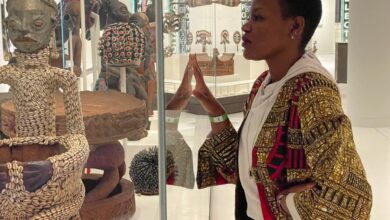
Germany’s Heritage Foundation Agrees To Return Stolen Ngonnso’ Statue To Cameroon
Germany’s Ethnological Museum of the Prussian Cultural Heritage Foundation on Monday said it will return a goddess statue that was…
Read More » -
Cameroon
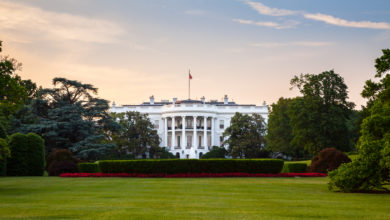
US Homeland Security Department Grants 18-Month Deportation Relief To Cameroonians
The United States (US) Department of Homeland Security (DHS) on Friday said the Biden administration has decided to grant temporal…
Read More » -
Cameroon
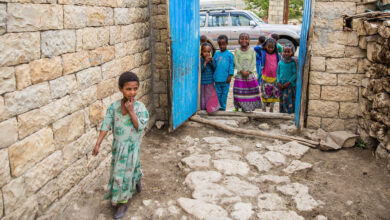
UNHCR Says Cameroon’s Intercommunal Clashes Continue To Displace Thousands
The United Nations Refugee Agency (UNHCR) on Friday said inter-communal clashes in Cameroon’s Far North region have forced at least…
Read More » -
Cameroon
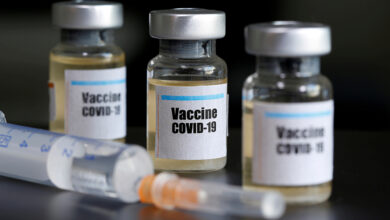
Cameroon Receives 200,000 Doses Of China’s Sinopharm COVID-19 Vaccine
Cameroon on Sunday received 200,000 doses of China’s Sinopharm vaccine, the first vaccine to arrive in the country, reported Anadolu…
Read More » -
Cameroon
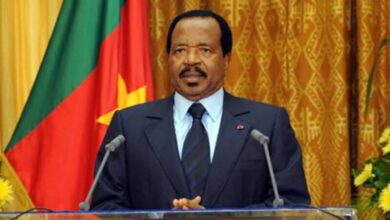
Cameroon: President Paul Biya Calls For People Behind School Attack To Be Arrested
Cameroon’s President Paul Biya has called for the people behind the attack on a school in the country’s Southwest region…
Read More » -
Cameroon

Cameroon: President Paul Biya Announces Regional Elections Scheduled In December
Cameroon’s President Paul Biya has announced the first regional elections in the country will be held in December this year,…
Read More » -
Cameroon

Cameroon: President Paul Biya Addresses Nation For First Time Amid Coronavirus Crisis
Cameroon’s President Paul Biya addressed the people on Tuesday for the first time in two months since the coronavirus crisis…
Read More » -
Cameroon
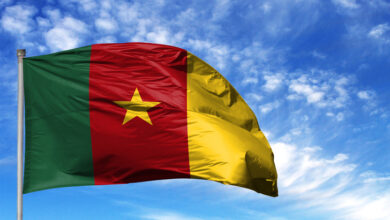
Cameroon Election: Sunday Voting Overshadowed By Separatist violence
The people of Cameroon voted on Sunday in the much delayed parliamentary and municipal elections that were held for the…
Read More » -
Cameroon
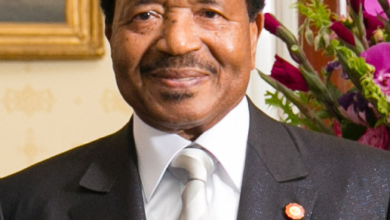
Cameroon: Washinton Puts Sanction On President Paul Biya’s Regime
A new report suggests President Donald Trump led US government has placed sanctions on Comoros President Paul Biya’s regime. The…
Read More »

